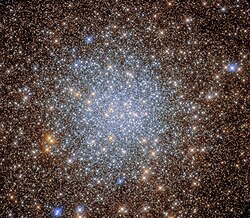Astronomy:NGC 6569
From HandWiki
Short description: Globular cluster in the constellation of Sagittarius
| NGC 6569 | |
|---|---|
 Hubble Space Telescope image of NGC 6569 | |
| Observation data (J2000 epoch) | |
| Class | VIII |
| Constellation | Sagittarius |
| Right ascension | 18h 13m 38.88s[1] |
| Declination | −31° 49′ 35.2″[1] |
| Distance | 35.5 kly (10.9 kpc)[2] |
| Apparent magnitude (V) | 9.47[1] |
| Apparent dimensions (V) | 7.0′ × 7.0′[2] |
| Physical characteristics | |
| Metallicity | = -0.76[3] dex |
| Other designations | GCl 91, ESO 456-77, VDBH 260[1] |
NGC 6569 is a globular cluster in the constellation Sagittarius. It has an apparent magnitude of about 9.5,[1] and an apparent diameter of 7 arc minutes, and class VIII with stars of magnitude 15 and dimmer.[2] It is about 2 degrees south east of Gamma2 Sagittarii. The globular cluster was discovered in 1784 by the astronomer William Herschel with his 18.7-inch telescope and was catalogued later in the New General Catalogue.[4]
References
- ↑ 1.0 1.1 1.2 1.3 1.4 "NGC 6569". SIMBAD. Centre de données astronomiques de Strasbourg. http://simbad.u-strasbg.fr/simbad/sim-basic?Ident=NGC+6569.
- ↑ 2.0 2.1 2.2 "NGC 5634". http://spider.seds.org/spider/MWGC/n5634.html.
- ↑ "Catalog of Parameters for Milky Way Globular Clusters". http://physwww.mcmaster.ca/~harris/mwgc.dat.
- ↑ Courtney Seligman. "New General Catalog Objects: NGC 6550 - 6599". http://cseligman.com/text/atlas/ngc65a.htm#6569.
External links
 |

